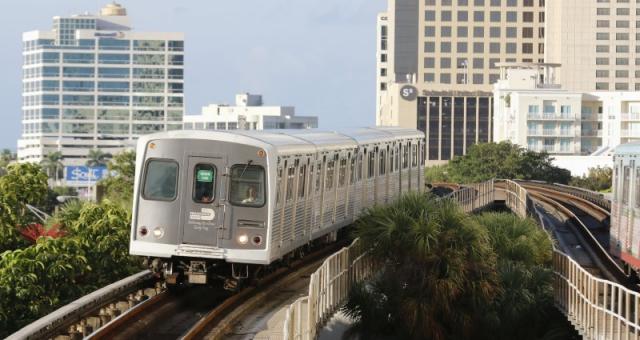Traffic gridlock in Miami
Spurs search for transit solutions
By David
Adams and Zachary Fagenson
MIAMI
(Reuters) - With little land left to build on between the Everglades and the
Atlantic Ocean, Miami developers are going vertical, converting the city from a
sprawling suburbia to a dense metropolis.
Dazzling
luxury condo towers designed by top architects highlight what some have called
the "Manhattanization of Miami." But with the glamor come mounting
traffic woes, and politicians and residents are scrambling for long-neglected
mass transit solutions.
Miami has
risen to between 7th and 12th on two U.S. indexes for worst traffic congestion.
The city has one of the least-developed mass transit systems among the world's
major metropolitan areas.
Gridlock
could tarnish the gloss on Miami's image and hurt efforts to lure new residents
and companies to its sunny shores, civic leaders fear. They warn that without
swift action, such as an expanded Metrorail system, rapid bus lanes and
trolleys, people may find themselves trapped in their fancy pads.
Imagine the
nightmare, says Seth Gordon, a Miami publicist: "You just bought an
apartment, the view is to die for and the amenities are wonderful, but you
can't get out."
Downtown
Miami had 80,750 residents in 2014, double its population in 2000. On weekdays,
the number of people in the city center surpasses 222,000.
It is poised
to get more crowded as the massive $1.05 billion Brickell City Center nears
completion, with a shopping mall, two office towers, almost 900 apartments and
a hotel. Just to the north, the $1.7 billion Miami Worldcenter is under
development, including a 765,000-square-foot mall, an 1,800-room hotel, and a
60-story condominium tower.
Exacerbating
the traffic problem is a lack of affordable housing in the city center, forcing
many to commute from the suburbs of Miami-Dade County, with a population of 2.6
million residents across 2,400 square miles.
Since the
market revived in 2011, 239 new condo towers with 33,738 units have been
proposed or are under construction in Miami-Dade County, according to Peter
Zalewski of Miami-based real estate consultant Condo Vultures.
WATER
BUSES AND BIKE TRAILS
Mass transit
advocates say Miami has a lot of work to do.
The city's
bus system is notoriously inefficient. Its Metrorail was only recently extended
from downtown to the Miami airport, one of the busiest in the country. There is
no rail link from the airport to the biggest tourist attraction, Miami Beach,
or the downtown port of Miami which handles 5 million cruise ship passengers a
year.
A public
outcry over traffic congestion has prompted officials to look for ways to
create an interconnected mass transit network, including dedicated rapid bus
transit lanes, city trolleys, bike trails and even water buses.
"For
decades we promoted a lifestyle of freedom of mobility that relied on the car
and now the chickens are coming home to roost," said Miami-Dade County
Commissioner Esteban Bovo.
Most agree
that Miami's roads are maxed out. Still, expansion of the Metrorail at $100-200
million per mile would take years, and funding it would likely require private
venture capital.
A five-day
"green mobility" event this week called WHEELS is promoting hybrid
solutions combining bus, rail and bike trails, with low-cost taxi services such
as Uber and Lyft filling the gaps.
"Young
professionals today want to live in urban areas and look less to cars,"
said Juan Mullerat, an architect and urban planner with PlusUrbia Design.
Over the
past five years, the long under-utilized Metrorail has increased annual
ridership by 24 percent, local officials said.
"It
saves me time and it saves me money," said Arlen Polanco, 36, a nurse who
rides Metrorail to work because the journey by car had become unbearable.
Civic
activist Norman Braman, owner of Miami's largest car dealership, urges smarter
traffic light synchronization that can read real-time congestion, along with
steps such as Venice-style vaporettos or water buses.
"The
water is already there, we don't have to wait 10 to 15 years to build a rail
system," he said.
Braman, a
major financial backer of U.S. Senator Marco Rubio's 2016 Republican
presidential campaign, has led local efforts to defeat mass transit taxes over
the last two decades. He has argued that the public sector cannot be trusted to
spend the money efficiently to fix the problem.
Undeterred,
local authorities are stepping up future plans through a $2 billion bond issue,
including money for new diesel-electric buses equipped with Wi-Fi and a new
mobile app to track buses.
New
ordinances also allow downtown developers to build fewer parking spaces in new
buildings to encourage a "rider-transit" culture. A recent project by
Related Group, one of Miami's largest real estate firms, offered 40 studios
downtown with no parking.
"People
want urbanization," said Carlos Rosso, the firm's president. "I
happen to own one and I rent it out without problem."
(Writing by
David Adams; editing by Colleen Jenkins and David Gregorio)


No comments:
Post a Comment